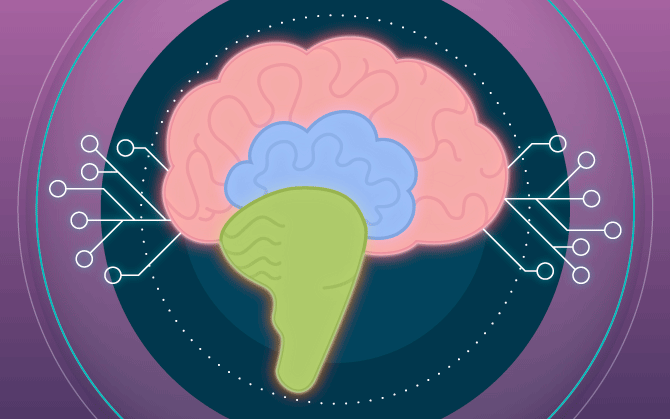
Learn how to improve your memorization skills, creativity and the organization of ideas with mental mapping
Understand what mental mapping is and how it can be applied to various areas of your life!

What will we see in this post
Have you ever been in a situation where you’re preparing to give a work presentation and you write down key terms to help you remember the content better? Or have you ever marked your notes with multicolor highlighter pens? These are techniques for memorization and organization that can evolve into a mental map.
Never heard of this? Mental maps are diagrams of ideas. With them, you’re able to help your brain create connections between information. The result is that this is a useful tool for the development of creativity, retain what you’ve learned and stimulate the systemic view of concepts. Keep reading and learn how to build them all!
What is mental mapping?
Well, mental mapping is a diagram in which you organize ideas and information in such a way that makes it easier for your brain to record them; thus the name. It has mental paths that lead to a central theme.
In order for the map to be truly effective in creating connections and associations, it is built with a few elements that our brain apparently likes best, which is what Tony Buzan has studied. He is a psychologist who has specialized in learning processes and who created the mental mapping method.
For him, certain things favor neural synapses, which create associations of ideas and concepts. For example:
- Colors instead of black and white;
- Curved instead of straight lines;
- Isolated words instead of phrases;
- Symbols instead of texts;
- Hierarchical instead of random arrangement.
These elements are used to organize connecting ideas and memories. More or less like this: Sustainability —> Environment —> Waste Collection —> Recycling.
This is basically how mental mapping works, but with variation of the same theme.
Learn about the benefits of mental mapping
A mental map can be used for everything: To study for final exams, creative brainstorming, and even to organize daily domestic chores. Check out a few of its advantages!
1. It benefits memorization
First of all, mental maps are structured in a way that makes it very useful for memorization. This occurs because the brain will draw one idea from another one. And we’re not talking about “rote learning”. Memory really works better with visual and verbal associations.
To such an extent that certain brain exercises involving threads, images and spatial arrangements are widely studied as memory triggers. Have you ever read Sherlock Holmes? If so, you probably recall the iconic analogy between the brain and an empty attic.
Yes, the greatest detective of all time is a specialist in memorization through brain connections. In this case, his secret is the Method of Loci — in which information is spatially associated, which is one of the premises of mental mapping.
2. It develops creativity
In addition to being a great solution for the day before your exams, mental mapping is also great for those who need creativity. When you start writing down keywords as they pop up in your mind, interesting ideas will emerge.
After all, what your creativity doesn’t merely come out of thin air, right? Everything generated in our brain comes from a collection of experiences, memories and knowledge.

Therefore, creativity isn’t necessarily the capacity of thinking of something unique. It has much more to do with the right selection of a mental repertoire that evolves into a new idea. To this end, mental mapping is truly handy.
3. It contributes to the organization of ideas
Now, if your problem is neither memorization nor creativity, but you need to organize your ideas, we have good news for you. Mental mapping is also used for this!
Let’s suppose, for example, that a person who’s in college and is completely lost because they didn’t start studying until the last week before exams (yeah, like you’ve never done that before!).

Luckily, this college student ran into this post and started to create their mental map of pending academic studies. In the center is the college course’s name. Each branch corresponds to a class subject, with the keywords referring to the main topics they need to study.
Upon finishing the drawing, this student has a systemic view of the consequence of having procrastinated. The result? A certain amount of guilt of course, but also much more clarity about the steps they’ll have to take to recuperate the semester.
Mental mapping helps you to visualize priorities, find prerequisites for each task and understand the problem better from a panoramic vantage point.
These characteristics also work well in the professional world, because they are critical in making strategic decisions.
Know where to apply mental maps
Now that you’re familiar with the benefits of mental mapping, you can see that it’s truly a tool for life. However, certain tasks welcome this type of mental organization better than others do. This is the case of the following:
- Business planning: Mental mapping greatly contributes to the development of professional strategies, especially due to its organization of priorities and its stimulus to creativity;
- Project management: When it comes to managing tasks, deadlines, goals and procedures, the diagram of ideas also comes in handy;
- Organization of activities: Does your time management come up short on a daily basis? Mental mapping can help you;
- Creative idea structuring: The method also helps you nudge your creativity when it comes to creating content;
- Learning retention: As you’ve seen, one of the classic applications of mental mapping is the retention of subjects studied, since the technique favors memorization.
Learn how to build great mental maps
We already know a lot about mental mapping now, so let’s get down to what really matters: How do you build one? Check out these simple steps.
1. Reflect: the main theme
The first step is to reflect on the main theme. It will be the title of the diagram and must summarize all ramifications that start from the center. In other words, this is the central problem that guides your entire brainstorming process. A few examples are:
- “Cold War” for a study map;
- “Media plan” for a business meeting;
- “Financial education” for the planning of a lecture;
- “Supermarket” for a shopping list.
2. Branch off: find the subthemes
From this central theme, you can start creating ramifications. The lines must spread out from the map’s title and focus on the first associations that pop up in your mind. For example, a few probable branches for the themes we mentioned above are:
- Post World War II — space race — capitalism vs. communism — USA vs USSR;
- Branding — market segmentation — budget — media vehicles;
- Paying off debts — budget planning — savings account — investments;
- Cleaning products — staple foods — produce — bakery — personal hygiene — meat and dairy products.
3. Connect: help your brain remember
Now that you have your sub themes stemming from the central subject, it’s time to exercise your brain and work on the connections.
Unload the main ideas that stem from each branch, but remember to summarize them — keywords must be short and intuitive.
4. Associate: use visual aids
Our final tip is critical: while you’re building your mental map, you can go wild with visual aids, because they are one of the keys to success with this technique. Each branch can be written in a different color, for example.
In addition, sub themes belonging to the same family can have a specific symbol before it. The financial planning branch can include a dollar sign ($), while a savings account can include a piggy bank symbol — classic, huh?
Not to mention the layout of the branches: preferably, don’t make them linear. Pull them out of the center as if they were tree branches, so that the spatial configuration can also contribute to the method’s efficiency.
Check out 5 tools to create your mental maps
Although writing is an efficient way of extracting ideas and memorizing them, help from technology is always welcome. So, check out 5 tools to help you create a mental map digitally!
1. MindMeister
With a paid and a free version, MindMeister is one of the most popular pieces of mental mapping software — it has approximately 10 million subscribers. Its advantage is that it’s an online tool, so you can access from anywhere at any time.
2. FreePlane
FreePlane is free and a little simpler than the previous tool, but it’s still quite appealing. Its layout is pretty basic, and among its features is the possibility of inserting shapes, notes and interrelated links.
3. XMind
Now, if you want to go all in, how about a truly professional software? XMind has a free version, but its paid version is packed with features for those who want an impressive mental map. In addition, the application has a variety of stylish layouts.
4. MindNode
For those using Apple devices, MindNode is also a great option. It’s free, has an intuitive layout and a variety of shapes that can be inserted into the design. The app also has smart autofill, which comes in handy when your thoughts are pouring out.
5. Coggle.it
Finally, Coggle is free and has a clean look, and like MindMeister, is online. A cool feature is that Coggle is collaborative, i.e., more than one guest user can work on the same mental map.
Start organizing your ideas
Do you see how mental mapping is very useful for creativity, memorization and planning? Well, take advantage of our tips and choose one of these tools or go old school with paper and multicolor pens! This technique will certainly favor your productivity and learning process.
By the way, we have another article with how meditation can help you get more done. Take advantage of them and build a mental map based on them so you can practice! Your title might be “Mindfulness.” See you next time!




